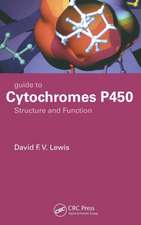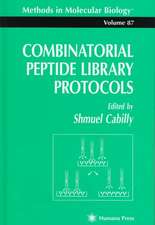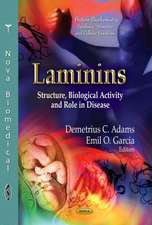Protein Targeting Protocols: Methods in Molecular Biology, cartea 88
Editat de Roger A. Cleggen Limba Engleză Paperback – 14 ian 1998
Din seria Methods in Molecular Biology
- 9%
 Preț: 791.59 lei
Preț: 791.59 lei - 23%
 Preț: 598.56 lei
Preț: 598.56 lei - 20%
 Preț: 882.95 lei
Preț: 882.95 lei -
 Preț: 252.04 lei
Preț: 252.04 lei - 5%
 Preț: 802.69 lei
Preț: 802.69 lei - 5%
 Preț: 729.61 lei
Preț: 729.61 lei - 5%
 Preț: 731.43 lei
Preț: 731.43 lei - 5%
 Preț: 741.30 lei
Preț: 741.30 lei - 5%
 Preț: 747.16 lei
Preț: 747.16 lei - 15%
 Preț: 663.45 lei
Preț: 663.45 lei - 18%
 Preț: 1025.34 lei
Preț: 1025.34 lei - 5%
 Preț: 734.57 lei
Preț: 734.57 lei - 18%
 Preț: 914.20 lei
Preț: 914.20 lei - 15%
 Preț: 664.61 lei
Preț: 664.61 lei - 15%
 Preț: 654.12 lei
Preț: 654.12 lei - 18%
 Preț: 1414.74 lei
Preț: 1414.74 lei - 5%
 Preț: 742.60 lei
Preț: 742.60 lei - 20%
 Preț: 821.63 lei
Preț: 821.63 lei - 18%
 Preț: 972.30 lei
Preț: 972.30 lei - 15%
 Preț: 660.49 lei
Preț: 660.49 lei - 5%
 Preț: 738.41 lei
Preț: 738.41 lei - 18%
 Preț: 984.92 lei
Preț: 984.92 lei - 5%
 Preț: 733.29 lei
Preț: 733.29 lei -
 Preț: 392.58 lei
Preț: 392.58 lei - 5%
 Preț: 746.26 lei
Preț: 746.26 lei - 18%
 Preț: 962.66 lei
Preț: 962.66 lei - 23%
 Preț: 860.21 lei
Preț: 860.21 lei - 15%
 Preț: 652.64 lei
Preț: 652.64 lei - 5%
 Preț: 1055.50 lei
Preț: 1055.50 lei - 23%
 Preț: 883.85 lei
Preț: 883.85 lei - 19%
 Preț: 491.88 lei
Preț: 491.88 lei - 5%
 Preț: 1038.84 lei
Preț: 1038.84 lei - 5%
 Preț: 524.15 lei
Preț: 524.15 lei - 18%
 Preț: 2122.34 lei
Preț: 2122.34 lei - 5%
 Preț: 1299.23 lei
Preț: 1299.23 lei - 5%
 Preț: 1339.10 lei
Preț: 1339.10 lei - 18%
 Preț: 1390.26 lei
Preț: 1390.26 lei - 18%
 Preț: 1395.63 lei
Preț: 1395.63 lei - 18%
 Preț: 1129.65 lei
Preț: 1129.65 lei - 18%
 Preț: 1408.26 lei
Preț: 1408.26 lei - 18%
 Preț: 1124.92 lei
Preț: 1124.92 lei - 18%
 Preț: 966.27 lei
Preț: 966.27 lei - 5%
 Preț: 1299.99 lei
Preț: 1299.99 lei - 5%
 Preț: 1108.51 lei
Preț: 1108.51 lei - 5%
 Preț: 983.72 lei
Preț: 983.72 lei - 5%
 Preț: 728.16 lei
Preț: 728.16 lei - 18%
 Preț: 1118.62 lei
Preț: 1118.62 lei - 18%
 Preț: 955.25 lei
Preț: 955.25 lei - 5%
 Preț: 1035.60 lei
Preț: 1035.60 lei - 18%
 Preț: 1400.35 lei
Preț: 1400.35 lei
Preț: 645.47 lei
Preț vechi: 759.37 lei
-15% Nou
Puncte Express: 968
Preț estimativ în valută:
123.51€ • 129.30$ • 102.20£
123.51€ • 129.30$ • 102.20£
Carte tipărită la comandă
Livrare economică 07-21 aprilie
Preluare comenzi: 021 569.72.76
Specificații
ISBN-13: 9780896034501
ISBN-10: 089603450X
Pagini: 331
Ilustrații: XII, 331 p.
Dimensiuni: 152 x 229 x 24 mm
Greutate: 0.56 kg
Ediția:1998
Editura: Humana Press Inc.
Colecția Humana
Seria Methods in Molecular Biology
Locul publicării:Totowa, NJ, United States
ISBN-10: 089603450X
Pagini: 331
Ilustrații: XII, 331 p.
Dimensiuni: 152 x 229 x 24 mm
Greutate: 0.56 kg
Ediția:1998
Editura: Humana Press Inc.
Colecția Humana
Seria Methods in Molecular Biology
Locul publicării:Totowa, NJ, United States
Public țintă
ResearchCuprins
Surface Plasmon Resonance.- Microcalorimetry of Protein-Protein Interactions.- Partitioning of Proteins in Triton X-114.- Co-Immunoprecipitation.- Overlay, Ligand Blotting, and Band-Shift Techniques to Study Kinase Anchoring.- Size-Exclusion Chromatography.- Overlay and Bead Assay.- Use of GST-Fusion and Related Constructs for the Identification of Interacting Proteins.- Molecular Genetic Approaches I.- Molecular Genetic Approaches II.- Molecular Genetic Approaches III.- Molecular Genetic Approaches IV.- Use of Synthetic Peptides in the Dissection of Protein-Targeting Interactions.- SH2 and SH3 Domains.- PH Domain of Serine-Threonine Protein Kinase B (RAC-PKB).- Membrane Targeting via Protein N-Myristoylation.- Membrane Targeting via Protein Palmitoylation.- Agonist-Mediated Turnover of G-Protein ?-Subunit Palmitoyl Groups.- Membrane Targeting via Protein Prenylation.- Nuclear Protein Import in a Permeabilized Cell Assay.- Clathrin-Coated Vesicles and Targeting.- Analysis of the Sorting of Secretory Proteins to the Regulated Secretory Pathway.
Recenzii
"... a valuable resource to the molecular biology community. The detailed protocols will greatly aid researchers..."-The Quarterly Review of Biology
Textul de pe ultima copertă
In Protein Targeting Protocols, master experimentalists describe, largely from the perspective of intracellular signaling, their best time-tested methods for detecting and analyzing the proteins and protein motifs involved in cellular targeting interactions. The techniques range from basic methods that reveal the existence of targeting interactions and characterize physicochemical properties to those for analyzing the more structurally elaborate systems involved in the movement of molecules between cellular compartments, with examples taken from nuclear transport, clathrin-coated vesicle traffic, and secretory sorting. The themes of targeting domains, particularly the SH-2, SH-3, and PH domains, and the principal targeting of lipid modifications-myristoylation, reversible palmitoylation, prenylation-are fully explored.
Protein Targeting Protocols offers a valuable collection of both basic and state-of-the-art techniques suitable for use in all areas of molecular cell biology by researchers interested in defining and characterizing the wide variety of protein interactions underlying targeting mechanisms. Readers will find it serves well as a firm methodological foundation for laboratories newly entering this field and as an indispensable reference work for those already well-established in it.
Protein Targeting Protocols offers a valuable collection of both basic and state-of-the-art techniques suitable for use in all areas of molecular cell biology by researchers interested in defining and characterizing the wide variety of protein interactions underlying targeting mechanisms. Readers will find it serves well as a firm methodological foundation for laboratories newly entering this field and as an indispensable reference work for those already well-established in it.


















